NAB at record highs - but can investors trust the recovery?
This month, loyal shareholders of National Australia Bank (ASX: NAB) finally have reason to celebrate – though the news is both sweet and bitter.
The sweet: NAB’s share price surged to a record high of $42.88, capping a remarkable five-year capital return of 137%.
The bitter: it took 213 months - nearly two decades since November 2007, when the stock last peaked at $42.66 before the GFC - to get there. And even now, NAB’s dividend remains below 2007 levels, meaning negative income growth over that entire period.
The contrast with arch-rival Commonwealth Bank of Australia (ASX: CBA) and Macquarie Group (ASX: MQG) is stark. NAB, by contrast, has spent the past five years under Ross McEwan and now Andrew Irvine cleaning up the trail of destruction left by their predecessors.
With input from veteran fundie Hugh Dive of Atlas Funds Management, we examine NAB’s missteps, its path to recovery, the leadership lessons for investors, and broker expectations for the road ahead.
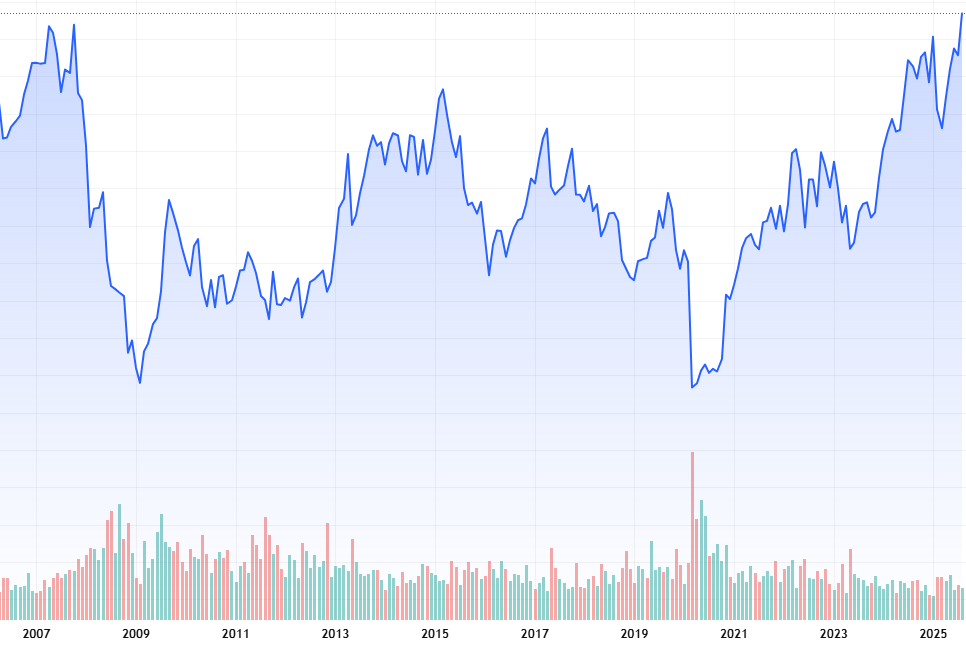
From “institutional arrogance” to global overreach: 1990s–2000s
For full disclosure, I was an employee of NAB from 2014 to 2019. One of the first things you learn in induction is a surprisingly candid history of the bank.
Insiders once proudly called it “the National,” and in the 1980s it held the title of Australia’s biggest bank. CBA leaned into mortgages, while NAB’s crown jewel was (and remains) its dominance in business lending.
But former CEO Don Argus (1990–1999) wanted more, launching a push for global dominance – a mission continued by successors Frank Cicutto (1999–2004) and John Stewart (2004–2008). The ambition was laid bare in NAB’s 1997 annual report, which declared its vision:
“To be the world’s leading financial services company.”
The genesis of this hubris was NAB’s relative strength coming out of the 1987 crash and 1992 recession.
“CBA didn’t list until 1991 and still had the grey cardigan brigade in charge, while ANZ and Westpac were busy blowing themselves up with reckless foreign adventures and over-exposure to Bond, Skase, et al,” Dive recalls.
“NAB emerged from this with an institutional arrogance that led them to believe they were superior to other banks, boasting better risk management systems. Why not take over the world and show the UK and US how banking is really done?”
What followed was a reckless two-decade buying spree - from second-tier UK lenders to a little-known bank in South Dakota and wealth manager MLC.

Livewire estimates the headline price tag for acquisitions in this era was north of $10 billion. The true cost was far higher once write-downs, fines, and reputational damage are factored in.
The chart below highlights the consequences of not having a deep understanding of an acquisition target: major losses and repeated shareholder dilution just to keep capital ratios within regulatory buffers.
With one disaster after another, NAB stumbled while CBA seized its Steven Bradbury moment. From around 2004, investors lost patience with “the National” and began awarding an ever-widening premium to what NAB insiders ruefully dub as “God’s bank".
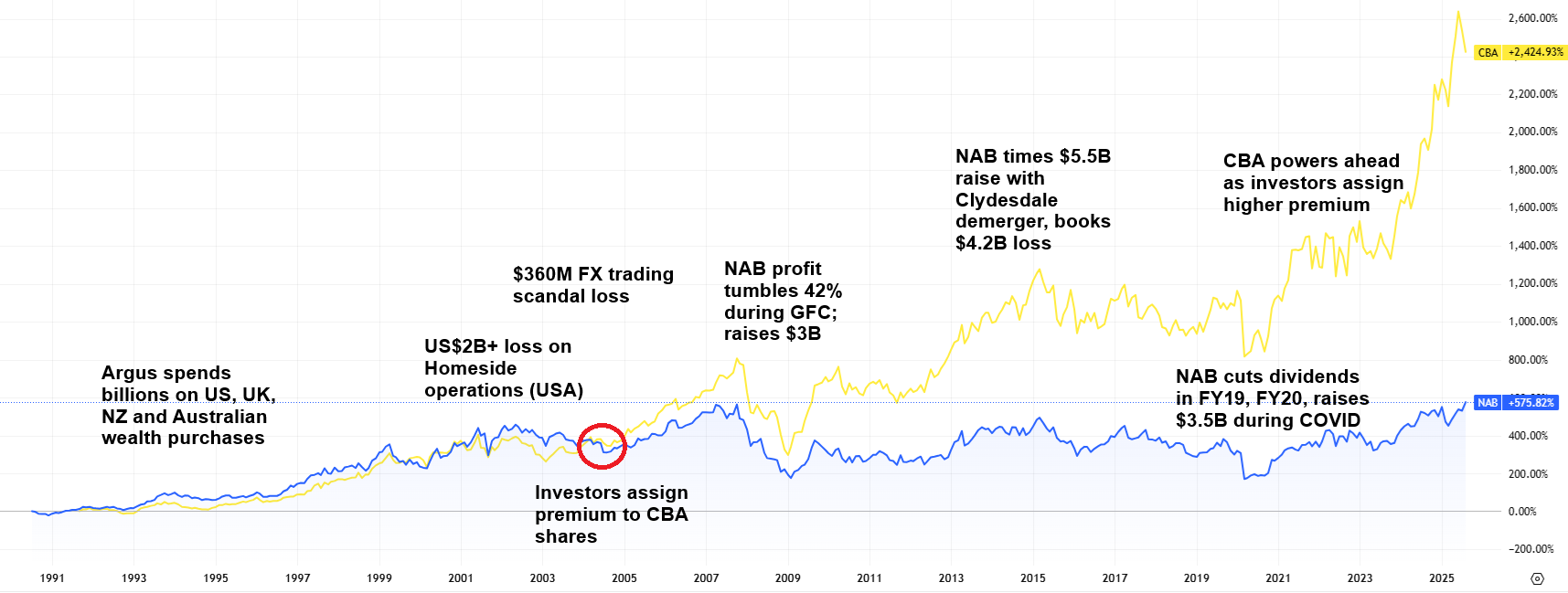
The makings of an income trap: 2010s
The echoes of those disastrous bets lingered into the 2010s. NAB offloaded assets like Great Western Bancorp in 2015 and Clydesdale in 2016, while paying millions in fines for mis-selling insurance in the UK.
Domestically, CEO Cameron Clyne (2009–2014) launched the viral “Break Up” campaign, slashing fees and mortgage pricing to lure customers from rivals. Customers loved it, but shareholders didn’t: NAB’s net interest margin fell from 2.24% in 2011 to 1.85% by 2017.
The share price drifted between $20 and $30 for much of the decade, briefly spiking above $37 in 2015 before slipping back. Inside NAB, frustration grew at how far behind CBA had pulled ahead technologically.
Clyne was a strong CEO for customers, but not for shareholders. His successor Andrew Thorburn (2014–2019) fared little better, trying to do everything at once: pour billions into technology, lift CET1 ratios, cover mounting fines - and still cling to an unhealthy dividend payout ratio above 80%.
As the table below shows, Thorburn never stood a chance of protecting NAB’s dividend. A flat income stream is just a slow slide into a negative one.
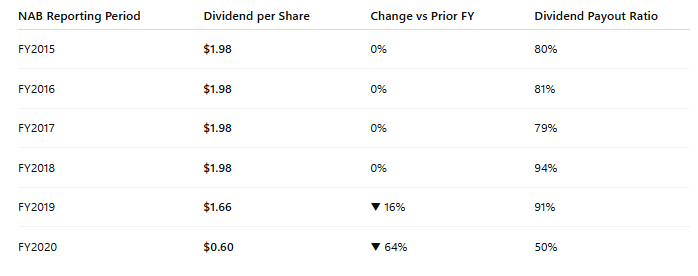
By the end of the 2010s, NAB was in fresh turmoil. The Hayne Royal Commission exposed deep cultural failings, with Commissioner Kenneth Hayne singling out chairman Ken Henry and Thorburn for poor performance. Both resigned in February 2019, leaving NAB’s reputation in tatters.
The ABC’s Stephen Letts captured the moment with savage precision in the following story:
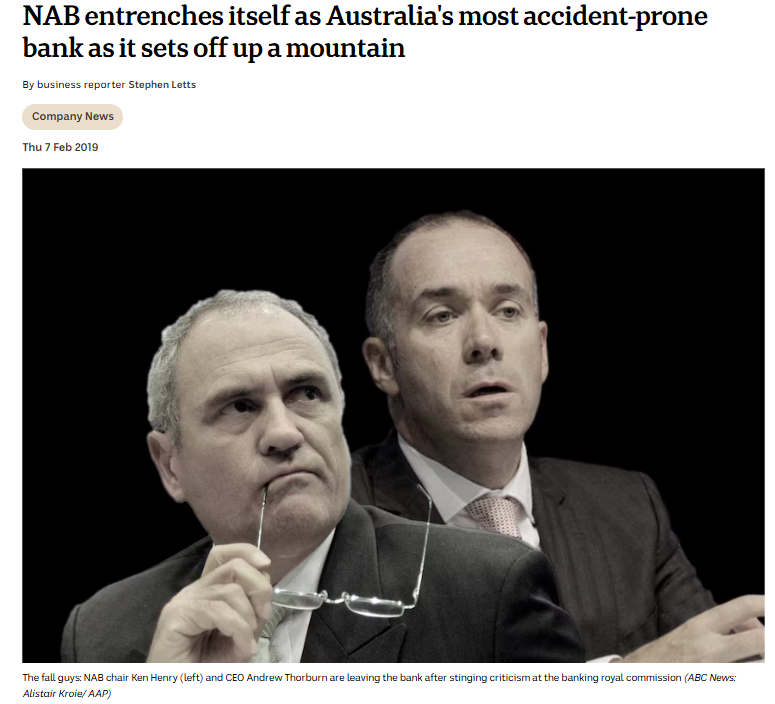
Finally, a turnaround? The 2020s
Ross McEwan (2019–2024), who had steadied the Royal Bank of Scotland after the GFC, was parachuted in as a stabiliser. He inherited scandals, a damaged brand, and shareholders addicted to unsustainable dividends.
Dive notes even McEwan stumbled early, raising $3.75 billion via 265 million new shares at $14.15, then paying out $910 million as a 30-cent dividend.
"It was a capital sleight of hand that issued additional shares cheaply, which were then repurchased at higher prices – sell low, buy high," he says.
Still, McEwan’s plain-speaking style and back-to-basics approach gradually won over investors. By 2023, NAB was stronger, steadier, and back on the radar.
In 2024, the baton passed to Andrew Irvine, recruited from Canada’s impressive Bank of Montreal (TSX: BMO). His playbook is the opposite of NAB’s past grandiosity. Instead, Irvine has zeroed in on fundamentals: rebuilding trust, listening to customers, and putting service at the heart of strategy.

It’s a model that helped BMO cement its reputation as one of North America’s premier dividend franchises, with 196 consecutive years of payments and six decades of consistent distribution increases.
Irvine is also unusually visible for a big-bank CEO, frequently posting on LinkedIn to congratulate staff and respond to customer feedback. As he put it in a 2024 video:
“I want to make NAB the most customer-centric bank in Australia and New Zealand.”
A decisive step came that year when NAB finally sold its remaining stake in MLC – a long-time underperformer.
Having retreated from its overseas misadventures and banking-adjacent businesses that it just couldn't maximise value from, Dive believes NAB is in "better hands" today.
Broker and fundie views: cautious optimism
Still, brokers are divided on whether NAB’s share price can keep rising.
Most expect underlying profit to hover around $6.5-7 billion over the next several years, with ROE easing from above 11% to between 10–11%. Consensus also points to a dividend cut in the first half of 2027 as competitive pressures intensify. The National also trades on a P/E of 18.64, compared to a historic average of ~13.
Broker targets are as follows:
- Macquarie: Neutral, $35.50
- Citi: Sell, $30.50
- UBS: Neutral, $37.50
- Morgan Stanley: Equal Weight, most optimistic at $39.80
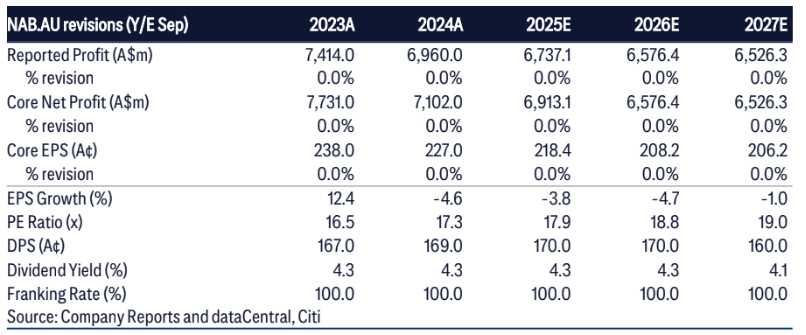
Morgan Stanley, the most constructive of the group, noted:
“We believe revenue trends are encouraging and costs are being well managed. Full trading multiples keep us at [equal-weight], but NAB is our preferred major bank. We think further progress on its three priorities and greater comfort on management changes are the key to share price outperformance vs peers.”
Those three priorities are: Defending business banking leadership, better deposit gathering, and expanding proprietary mortgage origination.
Dive, however, is more cautious - refusing to buy at current prices.
"It is hard to pay 18.6x for a company with no growth that operates in a highly competitive market, selling an undifferentiated product (loans and financial transactions) where their competitors have the same cost of capital," he says.
"Additionally, growth is limited to Australian credit growth/GDP growth, with no realistic prospects of new growth areas."
His preferred pick is Macquarie, which he says "while not cheap, has an excellent long-term record of growing earnings much faster than the big four domestic banks."
Final word
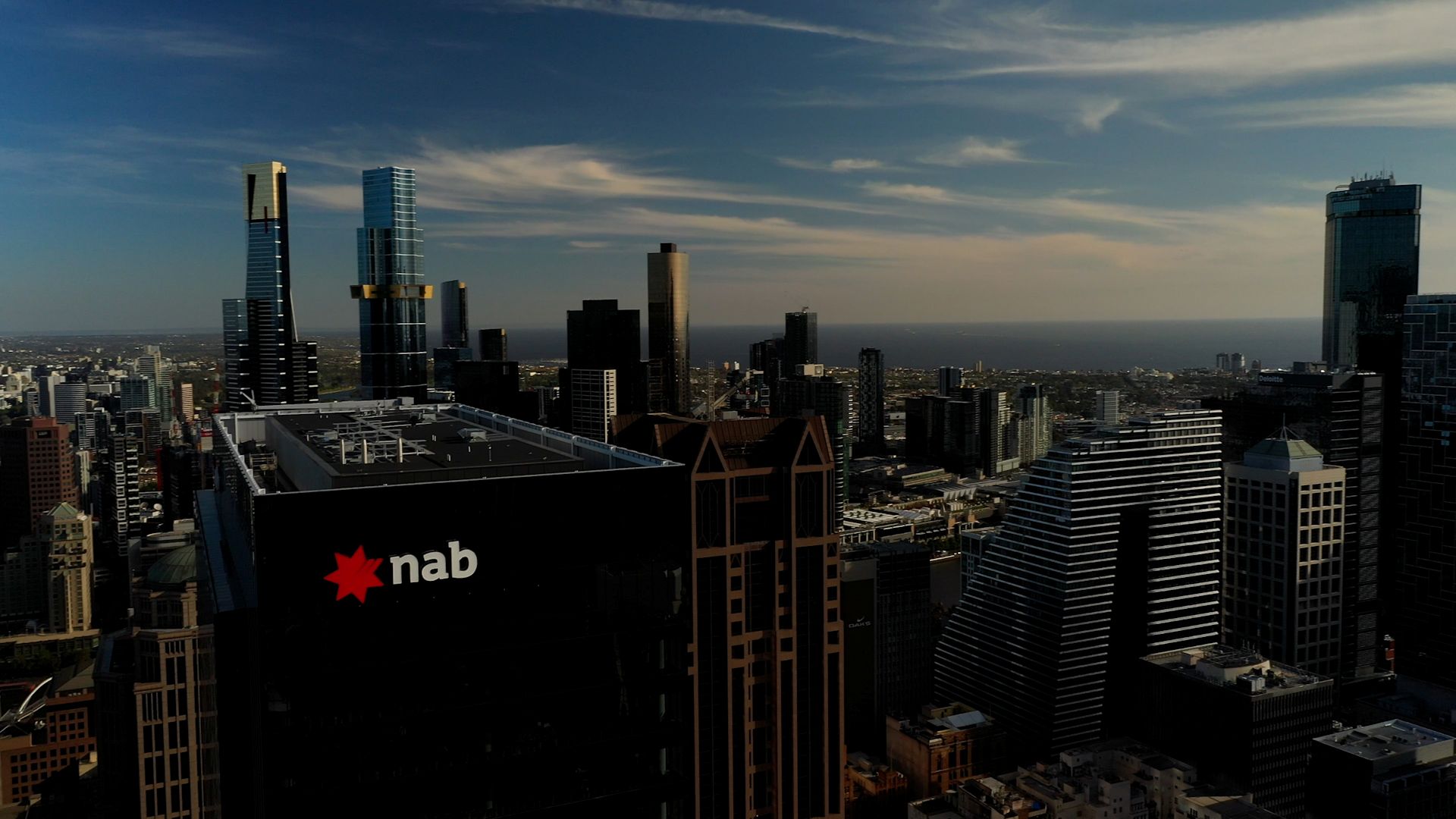
NAB today is a far stronger institution than the broken bank of the 2000s and 2010s. The divestment of underperforming assets, a renewed focus on its business banking crown jewel, and a concerted push to lift its retail offering have laid the foundation for a genuine turnaround.
But history still casts a long shadow. It took nearly two decades to reclaim its 2007 peak, and income investors remain worse off than they were before the GFC.
For Irvine and his successors, the lessons of the past must be non-negotiable: resist the temptation to get cute with acquisitions, avoid overpaying dividends only to claw capital back from shareholders, and embed humility deep within the management ranks.
Dive agrees:
"It would be a very courageous NAB CEO to announce a large offshore expansion or a return to areas like financial advice."
NAB will likely never replicate CBA’s astonishing run, but if Irvine and his successors remain grounded - recognising that banking is fundamentally a domestic game - and keep the focus on delivering quality products and reliable service at home, the next 20 years could be far brighter than the last 20.
Here’s to hoping the NAB curse is finally broken.
2 topics
1 stock mentioned
1 contributor mentioned

